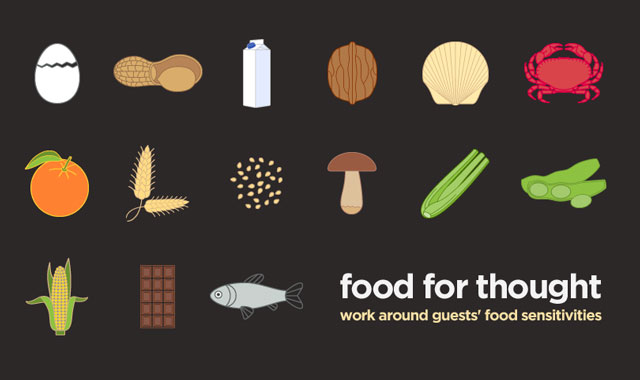Food for Thought — How to Work Around Guests’ Food Sensitivities
Between scheduling conflicts, delivery snafus, and logistical nightmares, now you can add “guests’ food sensitivities” to the lengthy list of planning hurdles to clear. While it may seem nearly impossible to avoid everything and still offer tasty cuisine, there are ways to work around these issues in order to make sure everyone is fed and happy. (Including the client!) Geri Wolf, Senior Event Designer at The Style Laboratory fills us in on the best way to approach this sensitive subject.
Q. Tell me about The Style Laboratory and what you do there.
A. I work as an event designer and planner, with a strong focus on food and beverage.
Q. Food allergies and sensitivities seem much more common these days. How do you address this when planning an event?
A. I do find there is a big difference between preferences, sensitivities, and allergies. Addressing this does present a challenge for a planner. For example, there are major differences between a person who is staying gluten-free as a lifestyle choice, someone who has a gluten sensitivity, and someone with Celiac disease. For those freely choosing to exclude gluten from their diet, consuming gluten occasionally isn’t likely to cause long-term negative effects, whereas someone who has a sensitivity may not feel well after consuming gluten. And of course, gluten can be life-threatening to someone with Celiac disease. A planner wants to be sensitive to their guests’ needs, especially any potential health risks, so the best way to approach the topic is by asking guests if they have dietary restrictions.
Q. How do you go about pre-planning for food allergies/sensitivities or even preferences (such as vegan or vegetarian)?
A. It depends on the style of the event. For example, if we’re serving a plated meal, we ask ahead of time. If it’s a cocktail reception, a dinner buffet, or food stations, we try to integrate options automatically--such as offering foods for those who are gluten sensitive, those avoiding pork or meat, or those who have allergies to shellfish or peanuts — and add signage designating foods as such. If it’s a plated meal, we do need to research our guests’ needs ahead of time. It just makes it easier to integrate that during the planning process. If we don’t, we put kitchen staff and the front of the house into a bad and embarrassing position.
Q. Is it costly to have to include so many variables?
A. It does come at an expense. For a plated meal option, it’s usually wise to offer two to three entrée choices. However, most kitchens aren’t equipped to offer kosher meals, so we must secure them from another source. The more varied types of meals we need to offer due to dietary restrictions, the more the price point increases.
Q. Are there certain foods that seem to mostly work for everyone?
A. Chicken, beef, and vegetables seem to be the tried and true. But it’s important to remember to still consider food sensitivities because things like marinades or sauces may contain gluten or peanuts.
Q. Any other tips?
A. It’s important to consider sensitivities are not just about food, but about beverages too. There are gluten-free beverages available in both alcoholic and nonalcoholic options.
It’s a question to bring up immediately with the host. Sometimes, if they know that cost is going to become a barrier, offering buffet or food stations might be preferable to a seated meal. It’s critical to be upfront with caterer right from the start. That way, they can come back with recommendations on what has worked well in the past and been successful for them.
The further ahead the planner and caterer know about food sensitivities, the easier it is to save money, hassle, and embarrassment. You don’t want to find out a guest has Celiac disease as they’re being seated at dinner.
Any time there are dietary restrictions, its important to disclose to the planner or guest that even if we’re trying to offer peanut- or gluten-free options, there could be cross-contamination no matter how careful they try to be in the kitchen. Sometimes, it may be necessary to secure their meals from an outside source that is certified peanut- and gluten-free. Or, give them the option to bring their own meal.










